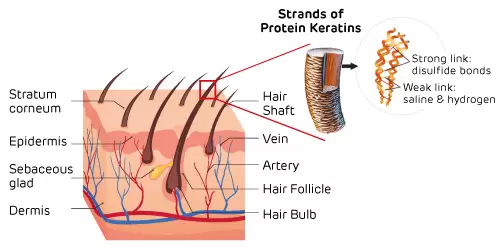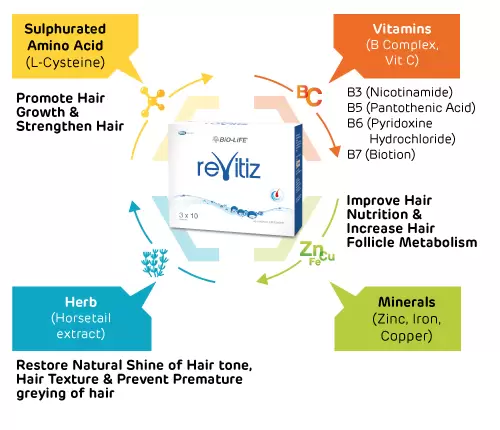
How to Nourish Your Hair From Within?
Sep 10, 2019
Introduction
Do you know?
- Each of us has about 100,000 number of hair follicles on our scalp since born.
- Each day, we lose between 50-100 hairs averagely, which later replaced by new ones.
- The hair follicles are not growing synchronously – the hair would not grow at the same time.
Have you ever wondered why we didn’t feel any pain when we cut our hair? Is our hair dead or living cells? The hair is made up of protein keratin, which grows starts from the hair root that located inside the hair follicles.

Figure 1: Hair keratin structure
| Important parts of the hair structure1:
Hair Follicles – Anchors each hair into the skin; it is the opening in the scalp that produces the hair Hair Bulb – Forming the base of the hair follicle, it consists of living cells that divide and grow to form the hair shaft Hair Shaft – The visible part of the hair, however, it is made up of death cells, which explained why we couldn’t feel any pain during a haircut. |
Hair is made up of a tough protein known as keratin, which grows out from the hair roots located in the dermis. Keratins are a group of cysteine-rich structural proteins that exhibit high mechanical strength because consisting of a large number of disulfide bonds.
At any point of the time, our hairs randomly fall into the three stages of hair cycle, namely Anagen Phase (Growing phase), Catagen Phase (Transition Phase), Telogen Phase (Resting Phase). For an adult, roughly 80% of the hair is in the growing phase. However, some people could experience hair loss due to several factors.
Hair loss happens when the speed of hair failing is faster than hair regrowth. Possible reasons contribute to hair loss including:
| Factors causing hair loss | |
| Lack of nutrients2 | Lack of protein intake from daily diet and deficiency in B vitamins are linked with hair loss. The protein – cysteine and methionine (the sulfur-containing amino acids) are the precursors to keratin hair protein synthesis. While vitamins and minerals including B vitamins, vitamin C, zinc, iron, copper, etc. are also vital for hair growth. |
| Aging | Aging is an inevitable cause for hair loss, due to our hair grow slower (shorter growing phase & prolong resting period) as we getting older. |
| Heredity3 | Our genetic blueprint for hair loss determines the hair loss onset, hair loss rate, and pattern of baldness. |
| Hairstyling & colouring4,5 | Hair loss can result from over styling and colouring. These physically weakening the hair shaft by disrupting protein backbone of the hair. Hydrogen peroxide founds in colorants that used to lighten the hair by breaking down melanin in the hair shaft, could lead to hair breakage and damage the hair follicle if used excessively. |
| Medical conditions | Certain medical conditions such as anemia, thyroid disorders, and autoimmune disease can lead to hair loss. |
| Hormonal changes6 | The dihydrotestosterone (DHT) can cause the hair follicles to shrink and inhibit the survival of healthy hair. Hormonal changes can contribute to the development of androgenetic alopecia, a type of hair loss commonly found in both men and women. |
| Table 2: Factors leading to hair loss | |
If you are having these risk factors and notice your hair fall out more than average rate, no worry, there is now a safe, drug-free remedy to help your hair regrowth back and reduce hair loss. This newly launched product care for your hair from within, with its 4-in 1 unique formulation, it provides complete nutrients that your hair ever needs to support healthy hair growth.

Figure 3: The 4 in 1 unique formulation for hair growth
References
- Martel, J.L., Badri, T. Anatomy, Hair Follicle. [Updated 2019 Jan 30]. In: StatPearls [Internet]. Treasure Island (FL): StatPearls Publishing; 2019 Jan-. Available from: https://www.ncbi.nlm.nih.gov/books/NBK470321/
- Goluch-Koniuszy, Z.S., 2016. Nutrition of women with hair loss problem during the period of menopause. Prz Menopauzalny., 15(1): 56–61
- Health Navigator New Zealand, 2019. Hereditary hair loss. Retrieved from https://www.healthnavigator.org.nz/health-a-z/h/hair-loss-normal-or-hereditary/
- Dermatology Times, 2017. Does hair dyeing facilitate hair loss? Retrieved from https://www.dermatologytimes.com/dermatology-times/news/does-hair-dyeing-facilitate-hair-loss
- Monselise, A., Cohen, D. E., Wanser, R., and Shapiro, J., 2017. What Ages Hair? Int J Womens Dermatol., 3(1 Suppl): S52–S57
- British Association of Dermatologists, 2015. Androgenetic alopecia. Retrieved from http://skinsupport.org.uk/conditions-details/androgenetic-alopecia



